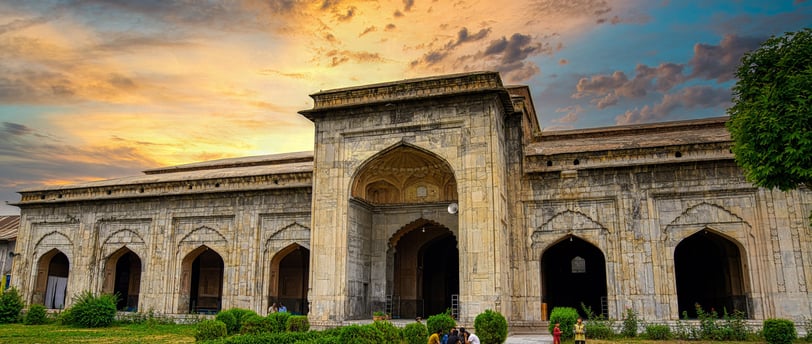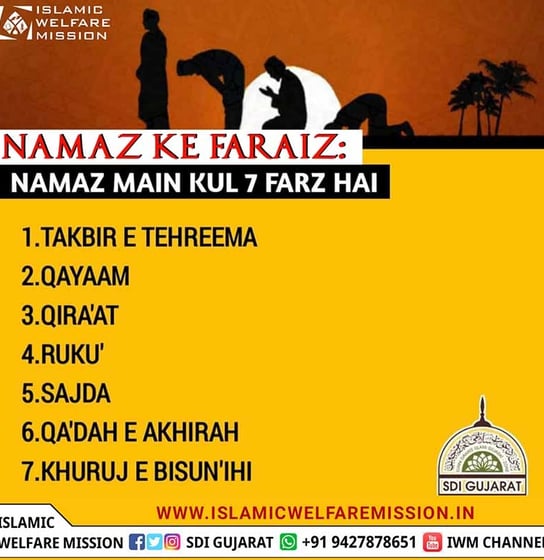How Many Faraiz In Namaj In English
Namaj, also known as Salah or prayer, holds significant importance in the lives of Muslims. It is an act of worship that allows individuals to establish a connection with their Creator, seek spiritual fulfillment, and find solace in their faith.
Vaseem Akram
7/12/20234 min read


How Many Faraiz in Namaj: Fully Explained
Namaj, also known as Salah or prayer, holds significant importance in the lives of Muslims. It is an act of worship that allows individuals to establish a connection with their Creator, seek spiritual fulfillment, and find solace in their faith. Understanding the faraiz, or obligatory acts, in namaj is essential for Muslims to perform their prayers correctly and with sincerity. In this article, we will delve into the details of the faraiz in namaj, shedding light on the 13 fundamental obligations that must be fulfilled during prayer.
## Table of Contents
1. Introduction
2. The Concept of Faraiz in Namaj
3. The First Faraiz: Takbir Tahrima
4. The Second Faraiz: Qiyam
5. The Third Faraiz: Qira'ah
6. The Fourth Faraiz: Ruku
7. The Fifth Faraiz: Sujud
8. The Sixth Faraiz: Jalsa
9. The Seventh Faraiz: Qa'da-e-Akhirah
10. The Eighth Faraiz: Qa'da-e-Ula
11. The Ninth Faraiz: Jalsatul Wusta
12. The Tenth Faraiz: Qunut
13. The Eleventh Faraiz: Taslim
14. The Twelfth Faraiz: Wajib Sajdah
15. The Thirteenth Faraiz: Tartib
## Introduction
Namaj is a beautiful act of worship that encompasses physical movements, recitation of Quranic verses, and supplications. It serves as a means of spiritual elevation and seeking closeness to Allah. To ensure that the prayer is valid, Muslims must fulfill the faraiz, which are the essential obligations prescribed by the Islamic faith. Let's explore each of these faraiz in detail.
## The Concept of Faraiz in Namaj
Faraiz in namaj refer to the mandatory acts that must be performed for the prayer to be considered valid. They are integral to the overall structure of the prayer and cannot be omitted or replaced. The fulfillment of these obligations demonstrates the sincerity and devotion of the worshipper.
## 1. Takbir Tahrima
The first faraiz in namaj is Takbir Tahrima, which marks the initiation of the prayer. It involves raising the hands to the ears and saying "Allahu Akbar," meaning "Allah is the Greatest."
## 2. Qiyam
Qiyam refers to the standing position during the prayer. It is the second faraiz and signifies the humility and submission of the worshipper before Allah.
## 3. Qira'ah
The third faraiz is Qira'ah, which entails the recitation of verses from the Quran. Muslims recite specific portions of the Quran during different units of the prayer.
## 4. Ruku
Ruku is the fourth faraiz and refers to the act of bowing down in the prayer. It symbolizes humility and submission to the Creator.
## 5. Sujud
Sujud, the fifth faraiz, involves prostrating on the ground with the forehead, nose, hands, knees, and toes touching the floor. It represents the utmost humility and surrender to Allah.
## 6. Jalsa
Jalsa is the sixth faraiz and signifies the sitting position between two prostrations. It allows a moment of rest and reflection during the prayer.
## 7. Qa'da-e-Akhirah
Qa'da-e-Akhirah is the seventh faraiz and refers to the final sitting position before concluding the prayer. It includes recitation of the Tashahhud and sending blessings upon the Prophet Muhammad (peace be upon him).
## 8. Qa'da-e-Ula
The eighth faraiz, Qa'da-e-Ula, is the initial sitting position after the second unit of prayer. It involves recitation of the Tashahhud and supplications.
## 9. Jalsatul Wusta
Jalsatul Wusta, the ninth faraiz, is the sitting position between the two prostrations in the second unit of prayer. It allows a moment of rest and reflection.
## 10. Qunut
The tenth faraiz is Qunut, which refers to the supplication made after the second prostration in the final unit of prayer. It is an opportunity to seek forgiveness, guidance, and blessings from Allah.
## 11. Taslim
Taslim is the eleventh faraiz and denotes the conclusion of the prayer. It involves turning the head to the right and left while saying the Salaam (greetings of peace).
## 12. Wajib Sajdah
The twelfth faraiz, Wajib Sajdah, refers to the prostration that is performed after reciting specific verses of the Quran. It is an additional act of prostration that enhances the prayer's spiritual significance.
## 13. Tartib
The thirteenth and final faraiz is Tartib, which emphasizes the correct sequence and order of the prayer's components. It ensures that the worshipper performs the acts of prayer in the prescribed manner.
## Conclusion
Understanding the faraiz in namaj is crucial for every Muslim striving to perform their prayers with sincerity and devotion. The 13 faraiz discussed in this article provide a comprehensive overview of the obligatory acts that must be fulfilled during prayer. By adhering to these obligations, Muslims can enhance their spiritual connection with Allah and find solace in their faith.
## FAQs (Frequently Asked Questions)
1. How many faraiz are there in namaj?
There are 13 faraiz in namaj, which are the obligatory acts that must be fulfilled during prayer.
2. Why are the faraiz important in namaj?
The faraiz are essential in namaj as they form the fundamental obligations that validate the prayer and demonstrate the sincerity of the worshipper.
3. What happens if a faraiz is missed during namaj?
Missing a faraiz in namaj can invalidate the prayer. It is crucial to perform all the obligatory acts to ensure the prayer's correctness.
4. Can the order of the faraiz be changed during namaj?
No, the order of the faraiz cannot be changed during namaj. Adhering to the prescribed sequence is essential for the prayer to be valid.
5. How can one learn to perform namaj correctly?
To learn to perform namaj correctly, one can seek guidance from knowledgeable individuals, scholars, or attend Islamic educational programs that teach the proper method of prayer. In conclusion, performing namaj with a thorough understanding of the 13 faraiz ensures that Muslims fulfill their obligations towards Allah. It is not merely a physical act but a means of spiritual connection and devotion. By adhering to the prescribed faraiz, individuals can enrich their prayer experience and strengthen their bond with the Divine. May we all find tranquility and blessings in our prayers.






